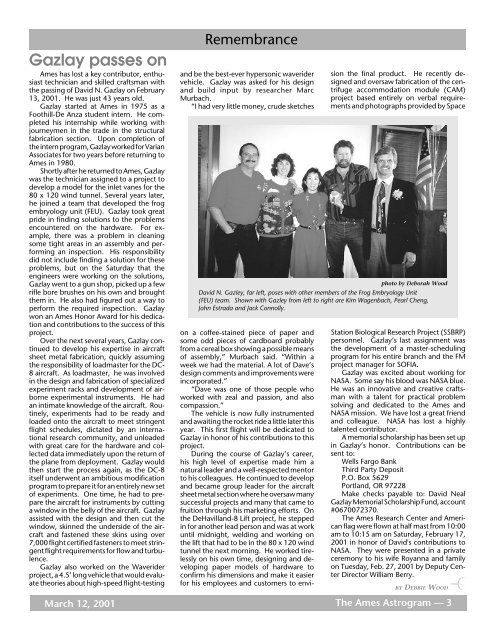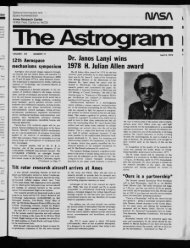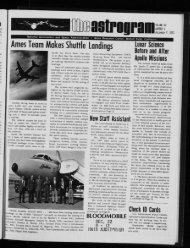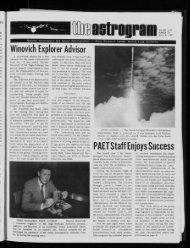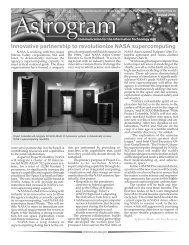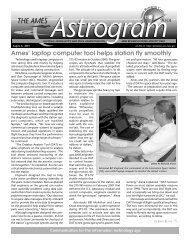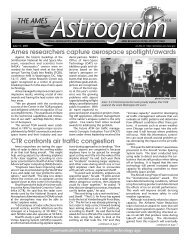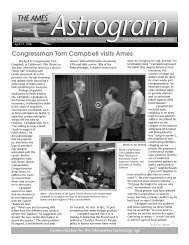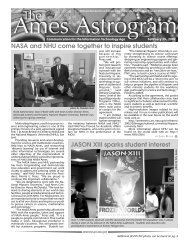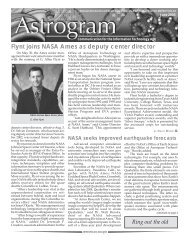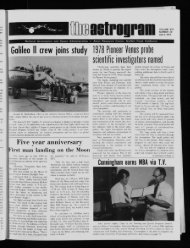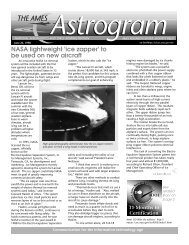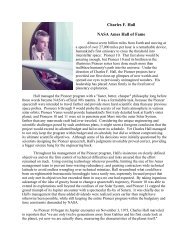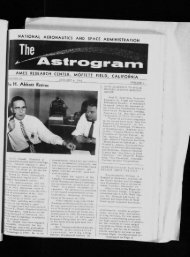3/12/01 Astrogram - NASA Ames History Office
3/12/01 Astrogram - NASA Ames History Office
3/12/01 Astrogram - NASA Ames History Office
You also want an ePaper? Increase the reach of your titles
YUMPU automatically turns print PDFs into web optimized ePapers that Google loves.
Gazlay passes on<br />
<strong>Ames</strong> has lost a key contributor, enthusiast<br />
technician and skilled craftsman with<br />
the passing of David N. Gazlay on February<br />
13, 20<strong>01</strong>. He was just 43 years old.<br />
Gazlay started at <strong>Ames</strong> in 1975 as a<br />
Foothill-De Anza student intern. He completed<br />
his internship while working with<br />
journeymen in the trade in the structural<br />
fabrication section. Upon completion of<br />
the intern program, Gazlay worked for Varian<br />
Associates for two years before returning to<br />
<strong>Ames</strong> in 1980.<br />
Shortly after he returned to <strong>Ames</strong>, Gazlay<br />
was the technician assigned to a project to<br />
develop a model for the inlet vanes for the<br />
80 x <strong>12</strong>0 wind tunnel. Several years later,<br />
he joined a team that developed the frog<br />
embryology unit (FEU). Gazlay took great<br />
pride in finding solutions to the problems<br />
encountered on the hardware. For example,<br />
there was a problem in cleaning<br />
some tight areas in an assembly and performing<br />
an inspection. His responsibility<br />
did not include finding a solution for these<br />
problems, but on the Saturday that the<br />
engineers were working on the solutions,<br />
Gazlay went to a gun shop, picked up a few<br />
rifle bore brushes on his own and brought<br />
them in. He also had figured out a way to<br />
perform the required inspection. Gazlay<br />
won an <strong>Ames</strong> Honor Award for his dedication<br />
and contributions to the success of this<br />
project.<br />
Over the next several years, Gazlay continued<br />
to develop his expertise in aircraft<br />
sheet metal fabrication, quickly assuming<br />
the responsibility of loadmaster for the DC-<br />
8 aircraft. As loadmaster, he was involved<br />
in the design and fabrication of specialized<br />
experiment racks and development of airborne<br />
experimental instruments. He had<br />
an intimate knowledge of the aircraft. Routinely,<br />
experiments had to be ready and<br />
loaded onto the aircraft to meet stringent<br />
flight schedules, dictated by an international<br />
research community, and unloaded<br />
with great care for the hardware and collected<br />
data immediately upon the return of<br />
the plane from deployment. Gazlay would<br />
then start the process again, as the DC-8<br />
itself underwent an ambitious modification<br />
program to prepare it for an entirely new set<br />
of experiments. One time, he had to prepare<br />
the aircraft for instruments by cutting<br />
a window in the belly of the aircraft. Gazlay<br />
assisted with the design and then cut the<br />
window, skinned the underside of the aircraft<br />
and fastened these skins using over<br />
7,000 flight certified fasteners to meet stringent<br />
flight requirements for flow and turbulence.<br />
Gazlay also worked on the Waverider<br />
project, a 4.5’ long vehicle that would evaluate<br />
theories about high-speed flight-testing<br />
March <strong>12</strong>, 20<strong>01</strong><br />
Remembrance<br />
and be the best-ever hypersonic waverider<br />
vehicle. Gazlay was asked for his design<br />
and build input by researcher Marc<br />
Murbach.<br />
“I had very little money, crude sketches<br />
on a coffee-stained piece of paper and<br />
some odd pieces of cardboard probably<br />
from a cereal box showing a possible means<br />
of assembly,” Murbach said. “Within a<br />
week we had the material. A lot of Dave’s<br />
design comments and improvements were<br />
incorporated.”<br />
“Dave was one of those people who<br />
worked with zeal and passion, and also<br />
compassion.”<br />
The vehicle is now fully instrumented<br />
and awaiting the rocket ride a little later this<br />
year. This first flight will be dedicated to<br />
Gazlay in honor of his contributions to this<br />
project.<br />
During the course of Gazlay’s career,<br />
his high level of expertise made him a<br />
natural leader and a well-respected mentor<br />
to his colleagues. He continued to develop<br />
and became group leader for the aircraft<br />
sheet metal section where he oversaw many<br />
successful projects and many that came to<br />
fruition through his marketing efforts. On<br />
the DeHavilland-8 Lift project, he stepped<br />
in for another lead person and was at work<br />
until midnight, welding and working on<br />
the lift that had to be in the 80 x <strong>12</strong>0 wind<br />
tunnel the next morning. He worked tirelessly<br />
on his own time, designing and developing<br />
paper models of hardware to<br />
confirm his dimensions and make it easier<br />
for his employees and customers to envi-<br />
sion the final product. He recently designed<br />
and oversaw fabrication of the centrifuge<br />
accommodation module (CAM)<br />
project based entirely on verbal requirements<br />
and photographs provided by Space<br />
photo by Deborah Wood<br />
David N. Gazley, far left, poses with other members of the Frog Embryology Unit<br />
(FEU) team. Shown with Gazley from left to right are Kim Wagenbach, Pearl Cheng,<br />
John Estrada and Jack Connolly.<br />
Station Biological Research Project (SSBRP)<br />
personnel. Gazlay’s last assignment was<br />
the development of a master-scheduling<br />
program for his entire branch and the FM<br />
project manager for SOFIA.<br />
Gazlay was excited about working for<br />
<strong>NASA</strong>. Some say his blood was <strong>NASA</strong> blue.<br />
He was an innovative and creative craftsman<br />
with a talent for practical problem<br />
solving and dedicated to the <strong>Ames</strong> and<br />
<strong>NASA</strong> mission. We have lost a great friend<br />
and colleague. <strong>NASA</strong> has lost a highly<br />
talented contributor.<br />
A memorial scholarship has been set up<br />
in Gazlay’s honor. Contributions can be<br />
sent to:<br />
Wells Fargo Bank<br />
Third Party Deposit<br />
P.O. Box 5629<br />
Portland, OR 97228<br />
Make checks payable to: David Neal<br />
Gazlay Memorial Scholarship Fund, account<br />
#0670072370.<br />
The <strong>Ames</strong> Research Center and American<br />
flag were flown at half mast from 10:00<br />
am to 10:15 am on Saturday, February 17,<br />
20<strong>01</strong> in honor of David's contributions to<br />
<strong>NASA</strong>. They were presented in a private<br />
ceremony to his wife Royanna and family<br />
on Tuesday, Feb. 27, 20<strong>01</strong> by Deputy Center<br />
Director William Berry.<br />
BY DEBBIE WOOD<br />
The <strong>Ames</strong> <strong>Astrogram</strong> — 3


